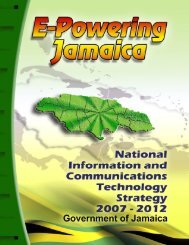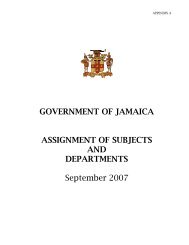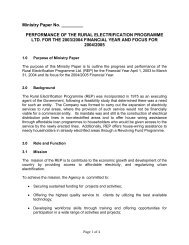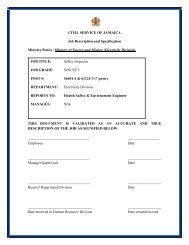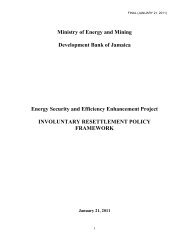Historically, sugar cane has been produced in <strong>Jamaica</strong> and other countries <strong>of</strong> Central Americafor centuries, and is highly suited to these tropical regions. <strong>Jamaica</strong>’s production has in the pastbeen significantly higher than it is currently, as can be seen in Figure 4. The last comprehensiveland use data for <strong>Jamaica</strong> shows that the cumulative area <strong>of</strong> plantation crops in 1998 was87,200 hectares 3 . FAO data for 1998 indicates that 36,000 ha <strong>of</strong> sugarcane were grown andmore might have been possible because the amount <strong>of</strong> idle cane land is unknown. Indeed, onlytwo years previously, in 1996, FAO reported that 45,000 ha <strong>of</strong> cane were grown. Earlier FAOdata indicates a maximum area used to grow cane <strong>of</strong> 81,800 hectares in 1961. The arearemained at about 60,000 hectares through the 1970’s before falling to about 40,000 until2000, after which a downward trend to the current 30,000 hectares occurred. Although someland has been lost to urbanization, a combination <strong>of</strong> ground observations and satellite imageryindicates that much <strong>of</strong> the areas used 50 years ago for cane remain available today. <strong>Jamaica</strong>would require an estimated 47,000 hectares 4 (including 4,000 ha for intervals, irrigation anddrainage infrastructure plus plots for trials and breeding) to produce all its current domesticneeds for granular sugar, molasses for rum production and ethanol to reach E10, so availability<strong>of</strong> adequate land does not appear to be an issue.Sugar cane is grown by relatively larger plantations that are owned or leased long term byindividual sugar mills, and by independent growers whose sizes <strong>of</strong> operation range from a fewhectares to several thousand. Due to its long history, local growers are quite familiar with thiscrop and given appropriate conditions should be able collectively to reach previous productionwhich cannot be said about alternative bi<strong>of</strong>uel crops without trials and further studies.While a number <strong>of</strong> factors have lead to the decline <strong>of</strong> sugar cane, the most important in recentyears is the removal <strong>of</strong> price support for <strong>Jamaica</strong>n sugar by the EU. This means that for thesector to expand, it needs to find a way to achieve economic sustainability by cost saving andrevenue enhancing measures. Optimising revenue from sales <strong>of</strong> granular sugar, molasses forrum, ethanol and sales <strong>of</strong> surplus electricity will require new approaches by all stakeholdersincluding the cane farmers. An examination <strong>of</strong> the current <strong>Jamaica</strong>n production system for caneand comparison with Brazilian practices by a cane specialist from that country has revealed thatmany improvements can be achieved with relatively low investment. The specialist also felt thatthe production <strong>of</strong> cane does not receive as much attention as it should and that the fields <strong>of</strong>tenappear quite abandoned or lacking application <strong>of</strong> latest technology applied. To correct thissome general policies are proposed to that focus on increasing the probability that futureproduction goals can be achieved. These policies fall into four main categories:1. Sugar cane varieties and observations2. Range <strong>of</strong> yields and ranges <strong>of</strong> sucrose and total sugars3. Varieties suited to soils with elevated salinity4. Work being undertaken by SIRI [based on visit to trial plots May 20]3 Forestry Department, Land Use Data 1998 – includes sugar cane, bananas, coconuts and fruit trees/bushes.4 The basis for the 43,000 ha is discussed later in this report12
1. Sugar cane varieties and observationsThe general conditions <strong>of</strong> <strong>Jamaica</strong> suggest that varieties specially adapted to highphotosynthesis efficiency are desirable because they convert solar energy to accumulate totalcarbon as sugars and fiber. More specifically, <strong>Jamaica</strong> should trial varieties with characteristics<strong>of</strong> the following types:a) High total sugar varieties rather than high sucrose, since rum and ethanol do not requiresucrose as granular sugar doesb) High fiber varieties where more bagasse is needed to allow a modern cogenerationplant to run year round, including varieties with high sucrose content and salinitytolerancec) Varieties that mature early or late to allow an ethanol plant to receive feedstock over alonger period annuallyd) Varieties <strong>of</strong> sweet sorghum as a supplement to sugar cane where it can help increaseoverall pr<strong>of</strong>itability or require less water and grow in dryer areasTo develop suitable varieties, the current cane-breeding program should be expanded in orderto select those that match the changes to the products and not just to focus on good varietiesfor granular sugar, as has been the past need.The ripening period seems to be quite challenging due to the absence <strong>of</strong> low temperatures orsevere drought throughout the year. The yields found in the visited mills show that there is alot <strong>of</strong> room to increase cane yield and sucrose content, especially through the introduction <strong>of</strong>new varieties.The SIRI plots visited are a testimonial that there is a huge potential to increase production withnew varieties, but the numbers are still relatively small for future sector growth plans. Thebreeding program receives material from the West Indies Central Sugar Cane Breeding Station(WICSBS), Barbados, but this source should not be relied upon solely. Cooperation with otherbreeding programs must be initiated with priority to programs with similar weather conditionsas <strong>Jamaica</strong>. Many breeding programs around the world are willing to have agreements withother places and countries in order to develop new varieties. We recommend that <strong>Jamaica</strong>considers contacting the following breeding centers with a view to establishing a workingrelationship with at least two in addition to the current relationship with WICSBS:(1) Sugar Breeding Institute (Indian Council <strong>of</strong> Agricultural Research), Combitore, Tamil Nadu,India [www.sugarcane-breeding.tn.nic.in](2) Philippines Sugar Research Institute (PHILSURIN), Victorias City, Negros Occidental,Philippines. [www.philsurin.org.ph](3) Indonesian Sugar Research Institute (P3GI), Jalan Pahlawan No 25, Pasuruan 67126,Indonesia [www.sugarresearch.org](4) Centro de Technologia Canavieira (CTC), Piracicaba, Sao Paulo, Brazil[www.ctcanavieira.com.br]13



